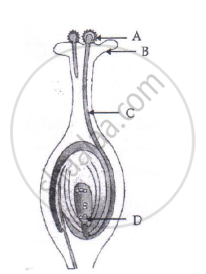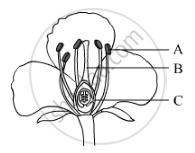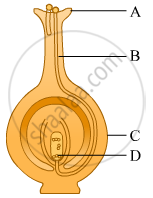Advertisements
Advertisements
प्रश्न
Calyx : Sepals : : Corolla : ________________
उत्तर
Calyx : Sepals : : Corolla : Petals
APPEARS IN
संबंधित प्रश्न

(i) Name the part marked 'A' in the diagram.
(ii) How dose 'A' reachese part 'B'?
(iii) State the importance of the part 'C'.
(iv) What happens to the part marked 'D' after fertilisation is over?
Name the parts A, B and C shown in the following diagram and state one function of each.

Mention the changes a flower undergoes after fertilisation.
A flower may have either male or female reproductive parts. Such a flower is called ______.
Explain what you understand by sexual reproduction.
Name the swollen lower part of the carpel.
Where are a plant's sex organs located?
What is the function of a flower?
Name the part of a seed which contains stored food.
Which of the following is the correct sequence of events of sexual reproduction in a flower?
(a) pollination, fertilisation, seed, embryo
(b) seed, embryo, fertilisation, pollination
(c) pollination, fertilisation, embryo, seed
(d) embryo, seed, pollination, fertilisation
One of the following occurs in the reproductive system of flowering plants as well as that of humans. This is :
(a) vas deferens
(b) anther
(c) ovary
(d) style
Which among the following statements are true for unisexual flowers?
(i) They possess both stamen and pistil
(ii) They possess either stamen or pistil
(iii) They exhibit cross pollination
(iv) Unisexual flower possessing only stamens cannot produce fruits
(a) (i) and (iv)
(b) (ii), (iii) and (iv)
(c) (ii) and (iii)
(d) (i), (iii) and (iv)
In the figure given alongside, the parts marked A, B and C are sequentially :
(a) cotyledon, plumule and radicle
(b) plumule, radicle and cotyledon
(c) plumule, cotyledon and radicle
(d) radicle, cotyledon and plumule
Fill in the blanks:
A stamen consists of ______ and ________.
Identify A, B, C and D in the given diagram and write their names.
Distinguish between unisexual and bisexual flowers giving one example of each. Draw a diagram showing process of germination of pollen grains on stigma and label the following parts:
(a) Female germ cell
(b) Male germ cell
(c) Ovary
Write the names of male and female reproductive parts of a flower.
Which of the following is not an unisexual flower?
a) Coconut
b) Papaya
c) Gulmohor
d) Maize
Prepare a slogan for campaign against female foeticide.
What is pollination? Mention its types.
Bisexual : Hibiscus : : Unisexual : ___________
What does germination mean?
Give scientific reason.
Fertilization in plants is called double fertilization.
Observe the figure below. Write functions of the labelled parts.

Where does the endothecium layer of anther lobes is present?
How many middle layers are generally present in the wall of the anther lobes?
Which type of development is observed in male gametophytes of plants?
The 3-celled egg apparatus at the micropylar end comprises of ______
Identify the female gametophyte in angiosperms.
What would be the number of chromosomes of the aleurone cells of a plant with 42 chromosomes in its roots tip cells?
Give reason for the following:
Fertilization cannot take place in flowers if pollination does not occur.
The ovaries of different flowers may contain
Trace the path a male gamete takes to fertilise a female gamete after being released from the penis.
State the number of sets of chromosomes present in a zygote.
Double fertilization means ______.
What is puberty?
